Add your feed to SetSticker.com! Promote your sites and attract more customers. It costs only 100 EUROS per YEAR.
Pleasant surprises on every page! Discover new articles, displayed randomly throughout the site. Interesting content, always a click away
Collins Law Firm
Naperville Personal Injury LawyerRace Discrimination Has Denied Black Patients The Kidney Transplants They Need to Survive 30 Oct 2024, 7:20 pm
For more than 20 years, Black patients with serious kidney disease have had their kidney function test scores artificially and unjustifiably inflated – increased – with the specific intent to make Black patients’ kidneys appear as though they were stronger, more efficient, and healthier than the actual test results showed them to be.
The result? Tens of thousands of Black kidney patients have systematically been deprived of the chance to be placed on the kidney transplant list – and the chance to receive the healthy, new kidney that they badly need to improve, and save, their lives.
Almost certainly, some have died waiting for a healthy kidney, and all because a test score designed to reveal their true, dangerously weakened kidney function was obscured by artificial inflation, and was used to keep them off the kidney transplant list.
There have been other consequences of this practice, too, such as the delay in other forms of health care to these patients, and their difficulty in qualifying for health insurance coverage---because the artificially inflated test score made necessary health care appear unnecessary, and thus gave insurers the excuse they are always looking for to not pay for it.
Why did this happen? Because the patients are Black. Race discrimination. Plain and simple. There’s no sugar-coating this, and sugar-coating just masks the gravity and indecency of what has happened here.
More than 20 years ago, “scientists” assumed – just assumed, without evidence – that Black patients had more muscle mass than white patients, and therefore that it was okay to ignore higher levels of muscle-tissue waste products – a key marker of weakened kidney function – in Black patients’ kidneys. This was B.S. “science” from the start, but it was used to “justify” adding points to – artificially inflating – the test scores for the kidney function for Black patients.
And only for Black patients.
Background/The Story:“UNOS” at the Center of the Discrimination
What happened here centers on an organization known as “UNOS”, which stands for United Network for Organ Sharing. UNOS is funded by American taxpayers. UNOS manages the national kidney transplant waiting list, matching donors to recipients.
Very important:UNOS is also responsible for making those policies that determine who is eligible to receive a donated kidney, and who is not. Until very recently, UNOS advocated use of the racially discriminatory, unjustified artificial inflation of kidney function test scores that operated to keep thousands of Black patients off the kidney transplant list.
Blacks Suffer More Kidney Failure, But Yet Have Less Access to Kidney Transplants
To appreciate the magnitude of what’s happened here, it’s important to understand that Black Americans are more than three times as likely to suffer kidney failure compared to White Americans. Black Americans are at higher risk for maladies such as high blood pressure, obesity, diabetes, and heart disease, each of which increases the likelihood of suffering kidney disease.
However, despite being overrepresented when it comes to kidney disease, Black Americans have been less likely than White Americans to actually receive a kidney transplant. In other words, Black Americans are more likely to need a kidney transplant, but less likely to get one. And the unjustified inflation of their kidney function test scores is a large part of the reason.
Unjustified Inflating of Black Patient Kidney Test Scores Has Harmed Hundreds of Thousands
Kidney function (i.e., how effectively kidneys filter waste from blood) is measured by a “glomerular filtration rate” test, commonly referred to as eGFR. A patient’s eGFR score is used to determine when the patient is eligible to begin accruing wait time on the national kidney waitlist, with the score needing to fall below 20 ml/min to qualify a patient to begin accruing wait time.
For more than two decades, UNOS used a race-based “coefficient” (i.e., a factor based solely on race) to artificially inflate observed kidney function (eGFR) scores for Black kidney disease patients.
The race-based “coefficient” delayed Black kidney disease patients from being added to the kidney transplant waitlist and resulted in Black candidates waiting much longer for kidney transplants than similarly situated non-Black candidates.
To emphasize the extraordinarily damaging impact of this unjustified, unscientific eGFR test score inflation for Black patients, a study published in eClinicalMedicine estimated that the effect of removing this inflation would result in:
- 300,000 more Black kidney disease patients qualifying for a beneficial referral to a kidney specialist (nephrologist) for evaluation and care
- 31,000 more of these patients becoming eligible for transplant evaluation and inclusion on the transplant waitlist
31,000!
These are the victims of race discrimination based on a scientifically unsupported racial stereotype.
UNOS Gets Outed----Forced to Admit that Black Kidney Patients “Have Become Very Ill or Have Died” Because of the Discriminatory Test Score Inflation
UNOS and many in the health care industry seemed quite content to continue to endorse and use this racially discriminatory test score inflation. They either didn’t care about the massive unfairness and injury it caused, or just didn’t care enough to ask the question. But they didn’t count on the guts, brains and decency of Dr. Nwamaka Eneanya, from the Perelman School of Medicine, and other colleagues who couldn’t abide this race discrimination. Dr. Eneanya lobbied extensively for the elimination of the test score inflation. Also, in 2019, she published a paper in the Journal of the American Medical Association, which shone a bright, national spotlight on this disgrace, and made it something that UNOS and organized medicine could no longer ignore.
UNOS had been outed.
In June of 2022, after the discrimination was exposed, UNOS was forced to admit its impact on Black Americans. On its website, UNOS said:
For a number of years, some eGFR calculations have included a modifier for patients identified as Black. This practice has led to a systemic underestimation of kidney disease severity for many Black patients. Specifically in organ transplantation, it may have negatively affected the timing of transplant listing or the date at which candidates qualify to begin waiting time for a transplant. (my emphasis)
Then, in January 2023, more admissions spilled out of UNOS, as it acknowledged “the use of a race-based calculation that has unfairly delayed care for many Black patients with kidney failure.” (my emphasis)
In that same published statement, UNOS also quoted Precious McGowan – a kidney transplant recipient herself, who serves on the Kidney Transplantation Committee – who used these damning words to describe the impact of the race discrimination that UNOS had endorsed:
“So many African-Americans have been affected by the use of the race-inclusive calculations [i.e., the artificially inflated eGFR test scores], and have become very ill or have died waiting for the opportunity to list for a kidney transplant.” (my emphasis)
“Had become very ill or died waiting”. For a kidney. Because they were Black. How shameful.
Dr. Lou Hart, Assistant Professor of Pediatrics (Hospital Medicine), and Medical Director of Health Equity, New Haven Health System, sadly expressed the damage this practice has done. Hart says it is “sickening to see the impact of this racialized equation and how it denies access to the very same patients who are most likely to need comprehensive kidney care. In the United States, African Americans are four times more likely to develop kidney failure than white patients, yet this racially biased eGFR equation makes Black patients’ kidneys look ‘healthier’ for longer.”
The architects of this race discrimination – and those who promoted it and benefitted by it, and those who ignored it while others suffered – must now be held accountable for the damage they have done.
Contact Us
If you believe you may have been the victim of the kind of race discrimination described here, and suffered because of it, please contact us. We will investigate the facts of your situation, and help you understand whether filing a legal claim is right for you.
Photo by Hannah Barata
The post Race Discrimination Has Denied Black Patients The Kidney Transplants They Need to Survive appeared first on Collins Law Firm.
Multi-Car Accidents: How to Determine Fault and Stay Safe 2 Aug 2024, 6:43 am
Many accidents on the road involve more than one car, especially accidents that occur in hazardous winter conditions or on the highway. These multi-car accidents often result in more serious injuries and greater liability than two car crashes. In addition, once the accident has happened, the danger has not necessarily passed. Moreover, liability—or who is responsible—can be especially difficult to determine. So, how can you figure out who is at fault, and what should you do if you have been involved in a multi-car accident?

Make Safety Your First Priority after a Multi-Car Accident
If you have been in a multi-car crash, your first priority should be staying safe. Stay in your car with your seat belt fastened until the police or EMTs tell you it is safe to exit. The biggest risk at this point is getting hit by another car after leaving your vehicle.
Make sure everyone else in your vehicle is OK and still wearing their seat belts as well.
If you are badly injured, call 911 to alert them to the fact that you need an ambulance and wait for the EMTs to come help you and transport you to a hospital. Of course, this also applies if anyone else in the car is seriously hurt.
Put your hazard lights on to warn oncoming traffic to slow down and steer clear of your car.
Protect Your Legal Rights After a Multi-Car Accident
From this point on, it’s crucial to take proactive steps to ensure your well-being and protect yourself legally. If you’re not seriously injured and law enforcement has indicated that it is safe to exit your vehicle, gather essential documentation from the other drivers involved. This includes exchanging contact information, insurance details, and vehicle registration documents. It’s also a good idea to write down your recollection of the accident while the details are fresh in your mind. Note the sequence of events, any relevant road conditions, and the positions of the vehicles involved. If possible, capture photographs of the accident scene, focusing on vehicle damage, road markings, and any contributing factors like weather conditions or obstructions.
Talking with the police officer overseeing the scene is another crucial step. Providing them with your account of the incident can help ensure an accurate record is included in the accident report. Be sure to communicate any pertinent details or observations you have regarding the circumstances leading up to the collision.
Notify your insurance carrier or agent about the accident as soon as possible. This allows them to initiate the claims process and begin assessing the damage to your vehicle. Timely notification also demonstrates your cooperation and commitment to resolving the matter efficiently.
Even if you don’t perceive any immediate injuries, it’s advisable to schedule a medical evaluation soon after the accident. Some injuries, particularly soft tissue injuries and concussions, may not be immediately apparent after a car accident. By seeking medical attention promptly, you not only safeguard your health but create a documented record of your condition following the accident. This can be invaluable in substantiating any injury claims you may pursue later on. Insurance companies often scrutinize claims involving delayed medical treatment, so seeking prompt medical care strengthens your position and credibility in any ensuing legal proceedings.
If you are injured as a result of the car accident — especially if you are seriously injured– one of the most important steps you can take is to seek the guidance of a qualified and experienced multi-car accident attorney. Your lawyer can provide invaluable support and advocacy, working to prove liability and pursue compensation for your injuries.
Contact an Attorney to Determine Liability for the Car Accident
It can be quite complicated to determine fault in a multi-car crash if no one admits liability, so you will most likely need your insurance company and an experienced car accident lawyer to do some investigating.
Typically, your insurance company will assign an accident investigator to your claim, and he or she will investigate the chain of events. However, if you have been injured in a serious accident, you should have your own lawyer doing a separate investigation on your behalf. He or she will speak to law enforcement, hire to a car crash expert to recreate the accident if necessary, and gather details about the chain of events, what the weather was like, the location and severity of damage on the cars, the position of the cars after the accident, the condition of the drivers involved, and any other detail that will help explain the accident.
In general, the amount of blame will be decided by the police officer who writes the report or the insurance adjusters. More often than not, the first car to start the chain reaction in a multi-car pile-up will be held liable. However, sometimes, more than one driver can be at fault, for example: one driver may be 60% at fault and another driver may shoulder 40% of the blame. This is why it is critical that you are protected. Your lawyer should be involved in the investigation from the beginning, to determine if small details—like a car speeding or driving too close to the car in front– point to one driver or another as the culprit.
How a Seasoned Multi-Car Accident Attorney Can Help
Because of the complications involved in a multi-car accident it critical to work with an experienced car accident attorney. In addition to representing your interests and ensuring fair treatment, a seasoned multi-car accident attorney can provide a multitude of invaluable services following a multi-car accident. As explained above, they can thoroughly investigate the accident scene, gathering evidence such as witness testimonies, police reports, and any available surveillance footage to establish liability. Next, they will communicate with the insurance companies on your behalf, protecting you from tactics aimed at minimizing your compensation. In addition, they will guide you through the legal complexities of filing a personal injury lawsuit, ensuring all deadlines are met and paperwork is properly filed. They will also negotiate skillfully to secure the maximum settlement possible, taking into account factors such as medical expenses, lost wages, property damage, pain and suffering, and any long-term rehabilitation or care needs. Finally, if a settlement is not possible, they will advocate for your rights in court, leveraging their experience to present a compelling case and fight for the compensation you deserve.
Speak to an Experienced Multi-Car Accident Attorney for FREE
Overall, entrusting your case to an experienced attorney like those at The Collins Law Firm can provide peace of mind during a challenging time, knowing that your legal matters are in capable hands and that you are taking the necessary steps to secure your future well-being. If you have been injured in a multi-car crash, call The Collins Law Firm at (630) 527-1595 to speak to an experienced car accident attorney about your claim for FREE.
The post Multi-Car Accidents: How to Determine Fault and Stay Safe appeared first on Collins Law Firm.
EPA is 50 Years Too Late in Cutting Emissions of Cancer-Causing Ethylene Oxide 1 Aug 2024, 6:43 am

For the last 50 years, EPA has buckled to pressure from the chemical industry, and basically done nothing to protect millions of Americans from breathing a life-threatening, cancer-causing chemical known as “ethylene oxide” (ETO). Along the way, EPA even repeatedly violated federal law – the “Clean Air Act” – by refusing to periodically make rules necessary to protect Americans against dangerous chemicals like ETO.
Let me say that again: EPA repeatedly violated the law. And it did so to benefit the corporations that profit from making, selling, using, and polluting with ETO.
Finally, on March 14, 2024, after being pressured by a lawsuit from environmental champion, Earthjustice, to force EPA to simply obey the law and protect us from ETO, EPA announced a rule requiring that US sterilization plants reduce their ETO emissions by 90%. ETO gas is used in the sterilization process to kill living things like bacteria, for example, found on the medical and other devices being sterilized.
ETO is an effective sterilant because it’s really good at killing living things. Here’s the problem: ETO can also cause cancer in people who inhale it. And after it’s done killing in the sterilization plant, the waste carcinogenic ETO gas is pumped out vents in the sterilization plant’s roof, left to blow in whatever direction the wind takes it – sometimes to nearby homes, school, parks, etc.
Worse still, ETO gas is colorless and odorless. So those breathing ETO don’t know it. And for the vast majority of US sterilization plants, until recently, no one warned local residents, parents, school children, etc., that a cancer-causing chemical was in the air they were breathing. This failure to warn is inhumane, with potentially devastating consequences: nearly 14 million people in the US and Puerto Rico live within 5 miles of a sterilization plant.
March 14’s EPA rule is said to be aimed at protecting residents near these plants. Especially the children, whose small bodies make them particularly vulnerable to ETO’s terrible consequences. EPA says this rule is an example of how the federal government protects us from environmental dangers.
But it is not. In fact, it is exactly the opposite. The truth is that the rule is an example of how government delay in protecting people – typically, as in the case of ETO, the result of corporate muscle and influence – causes intolerable suffering among those who most need and deserve government’s protection. And who, in most instances, are paying for that protection – in the form of their taxes.
The fact is that the federal government had known since at least 1977 that ETO can kill more than bacteria – it can kill humans, too. And yet 2024 is the first time ever that EPA made a rule meaningfully restricting – not eliminating, mind you – ETO emissions.
EPA is not a “protector of the people. “A protector of the corporations that make, sell and sterilize with ETO,” is a far more fitting title.
The sadly unanswerable question must nevertheless be asked: how many people living near these plants during the last 50 years have paid with their lives and health trusting that their government would warn them about the ETO they were breathing, let alone protect them against it?
Timeline of EPA Inaction on ETO
Here is just some of what the EPA and the federal government knew about the cancer-causing properties of ETO long before 2024:
- In 1977, a federal agency known as the National Institute for Occupational Safety and Health (NIOSH) concluded that ETO may increase the frequency of cell mutations – the building blocks of cancer – in workers exposed to ETO.
- By 1979, epidemiological studies (the studies of disease in human populations) showed that ETO can increase cancer deaths in workers.
- In 1981, NIOSH concluded that ETO should be considered a potential carcinogen in the workplace, and that there is no level of ETO that may be considered “safe.”
But none of this moved EPA to make a rule meaningfully restricting the use of ETO.
Despite this ominous proof of ETO’s threat to human life, the federal government then basically went to sleep on ETO for 35 years. During that time, it watched the proliferation throughout the US of sterilization plants that were spewing their waste ETO gas into residential communities. The people living, working, and going to school in those communities had no idea that a chemical as dangerous as ETO was getting into their lungs, let alone how dangerous it was when it got there.
Then, in 2016, largely based on evidence that had been available to the agency for decades, EPA announced the results of its long-overdue study on ETO. The study concluded:
- ETO is “carcinogenic to humans” who breathe it.
- “Exposure to ETO increases the risk of lymphoid cancer and, for females, breast cancer.”
Yet its own 2016 study caused no emissions-cutting rule from EPA.
In 2018, the Agency for Toxic Substances Disease Registry (ATSDR), studied the impact of ETO emissions in the residential community of Willowbrook, IL, in west suburban Chicago. The ATSDR study concluded:
- The concentrations of EtO in the air surrounding the sterilization plant create “an elevated cancer risk for residents and off-site workers in the Willowbrook community…”
- The elevated cancer risks in the community “present a public health hazard to these populations.”
This was the first time the people of Willowbrook had ever been told what they were breathing in their community’s air for the last 30 years. At that same time, EPA also announced that among the communities in the US with “unacceptable risk” for cancer were those with ETO-spewing sterilization plants.
In fact, one of the very worst cancer-risk communities in the US was the one immediately surrounding the ETO plant in Willowbrook, Illinois.
Still no emissions-cutting rule from EPA.
Understandably, the ATSDR report provoked shock and outrage in the previously ignorant residents of Willowbrook. This was especially true because of the prevalence in the area surrounding the sterilization plant of women with breast cancer – the cancer most strongly connected to ETO inhalation in the 2016 EPA study. More than 800 Willowbrook area people sued the operator of the Willowbrook sterilization plant, claiming that their cancers, or the cancers of a deceased loved one, had been caused by years of unknowing inhalation of the plant’s ETO.
More than 600 of these plaintiffs were area women with breast cancer. The case was known as In re Willowbrook Ethylene Oxide Litigation. (Willowbrook Litigation).
In February 2019, with an outraged local citizenry demanding answers from the sterilization plant’s operator, and the State of Illinois regulator asking hard questions for the first time in 35 years about cutting ETO emissions from the plant, the operator – frightened of the scrutiny – pulled up stakes and left town…rather than explain itself to residents, and drastically cut ETO emissions.
And still no emissions cutting rule from EPA.
In September of 2022, the first case in the Willowbrook Litigation went to trial. It involved a woman (Susan Kamuda) who had unknowingly inhaled the plant’s ETO for 22 years at her home 3 blocks away before she was diagnosed with breast cancer. After a 6-week trial, the jury awarded damages of $363 million. Extraordinarily, $325 million of the verdict was for “punitive damages,” reflecting the jury’s outrage at the years-long conduct that had led to Kamuda’s breathing such a dangerous chemical for decades without being given so much as the decency of a warning.
It was, and remains, the largest single plaintiff jury verdict in the 150+ year legal history of the State of Illinois.
Shortly after the Kamuda verdict, in December of 2022, Earthjustice sued EPA. Earthjustice noted that, despite the Clean Air Act’s requirement that EPA limit ETO emissions, and periodically review and revise ETO emission standards as necessary to protect human health, EPA had not done this, and was indeed violating the law.
Within months of the Kamuda verdict, the sterilization plant operator in the Willowbrook Litigation settled with the 800+ cancer victim plaintiffs by agreeing to pay them more than $400 million.
Neither the massive Kamuda verdict nor the massive settlement payment from the Willowbrook ETO plant operator moved EPA to declare an emissions-cutting rule.
Until now. Years too late for the Willowbrook cancer victims.
****
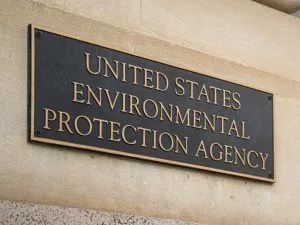
EPA’s half-century of callous neglect of the lives and health of millions of Americans breathing ETO is both shocking… and, sadly, routine. It is shocking because the agency that we pay and expect to protect us from ETO has betrayed us: it has seemed so often to be working for the other side, the one causing the threats.
But it is also routine. Because, while the story above may be nominally about ETO, the names of many other similarly toxic chemicals could be substituted for ETO, and the story would not change much. Chemicals such as PCB’s; the PFAS chemical family; TCE; asbestos; and mercury – where EPA has badly delayed or failed altogether to protect Americans from the threats of which the agency had long been aware. And this is to say nothing of the nearly 60,000 chemicals permitted to be on the market in the US despite absolutely no assessment of their risks to human health.
EPA’s working philosophy is that a chemical is “safe until proven dangerous.” Or sometimes “too safe to regulate, even after it’s proven dangerous.” That’s the story of ETO.
The bottom line of these enraging American stories does not change: the financial and political power of the chemical industry overwhelms and corrupts our scientific, legislative, and regulatory processes. Our government – EPA is but one example – mobilizes to protect the operations and profits of industry. And the lives and health of Americans are systematically sacrificed in the process.
ABOUT THE AUTHOR
Beginning in 2018, author Shawn Collins, along with Collins Law Firm colleagues, Ed Manzke and Maggie Galka worked with a team of lawyers to lead the fight for more than 800 residents of the Willowbrook, IL, area who had contracted cancer after unknowingly breathing a carcinogen known as ethylene oxide (EtO) for many years. The residents’ cases were consolidated into one mass litigation in Cook County (IL), In re Willowbrook Ethylene Oxide Litigation, Case No. 18 L 10475, before Judge Marguerite Quinn.
In recognition of his 20 years of environmental litigation experience, Shawn was appointed a co-lead of the Plaintiffs’ Executive Committee (PEC).
Shawn and Maggie served as co-counsel in the first trial, Kamuda, et al., v. Sterigenics U.S., LLC, et al., for Plaintiff Sue Kamuda, a breast cancer victim. On September 19, 2022, the jury returned Illinois’ largest-ever single plaintiff verdict against the defendants: $363 million. $325 million of the verdict (90%) was for punitive damages – an extraordinary repudiation of the defendants’ reprehensible conduct. Within months of the Kamuda verdict, the Willowbrook operator agreed to settle with the cancer victims by paying more than $400 million.
The post EPA is 50 Years Too Late in Cutting Emissions of Cancer-Causing Ethylene Oxide appeared first on Collins Law Firm.
THE DANGERS OF THE TOXIC CHEMICAL EMISSIONS FROM THE KOPPERS PLANT IN CICERO, IL 29 Jul 2024, 10:13 am
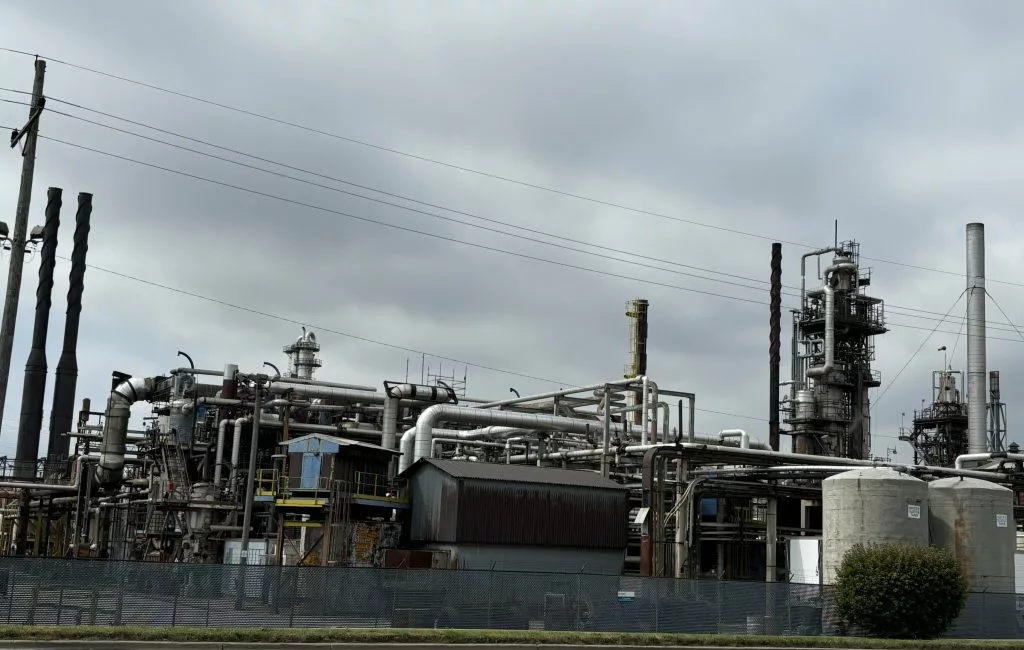
Who’s protecting the residents of Cicero and Stickney, IL, from the tons of toxic chemical emissions migrating from the massive, 36-acre Koppers coal tar plant at the corner of Laramie and Pershing roads? The danger is that these chemicals from Koppers are blowing into nearby residential neighborhoods and that the residents are breathing them. And they don’t even know it.
But I don’t see anyone protecting the residents against this threat. I don’t see anyone testing, for example, throughout these neighborhoods, and regularly, to see what concentrations of these toxic chemicals are getting to the residents and winding up in their lungs and bloodstreams. I don’t see that the residents are being warned of the chemicals’ dangers.
All I see is that Koppers’ emissions have made the air in the community surrounding the plant some of the most toxin-filled airin the country. Koppers knows this. So does the EPA. But the residents don’t.
Why is this all so dangerous for the residents?Six reasons:
The Chemicals Being Emitted Are Very Dangerous: They Are Linked to Cancer.
While Koppers emits many chemicals–and many tons of chemicals—each year (see section below for details), the most dangerous are benzene and naphthalene. Public health agencies whose job it is to study and report on the dangers of benzene and naphthalene, link prolonged exposure to these chemicals with cancer. Specifically:
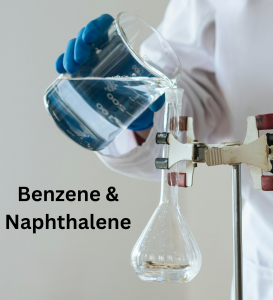
Benzene:USEPA and the International Agency for Research on Cancer (IARC) and the National Toxicology Program (NTP) have concludedthat benzene is a “known human carcinogen”; “carcinogenic to humans”; and “known to be a human carcinogen”, respectively. In other words, prolonged benzene exposure is known to cause cancer in humans.
What types of cancer? The cancers most frequently linked to benzene exposure areleukemias and lymphomas.More specifically:
- In children: Leukemia, especially Acute Myeloid Leukemia (AML)
- In adults: AML, Chronic Lymphocytic Leukemia, non-Hodgkin’s Lymphoma and Multiple Myeloma.
Naphthalene:The State of California has declared that naphthalene is “known to the State of California to cause cancer in humans”. NTP has concluded that naphthalene is “reasonably anticipated to be a human carcinogen”. Both IARC and USEPA say the chemical is possibly carcinogenic to humans.
The cancers linked to prolonged naphthalene exposure includelung cancer and cancer of the larynx and colorectal system.
It is important to keep in mind that public health agencies study industrial chemicals like benzene and naphthalene regularly, and frequently conclude that they are more dangerous than previously believed, or are linked to more cancers than previously thought.
Clearly, benzene and naphthalene are dangerous. They do not belong in residential neighborhoods, and even less inside the bodies, lungs, and bloodstreams of human beings.
Koppers Emits Massive Quantities of Dangerous Chemicals Every Year—in One Year, more than 75 Tons.
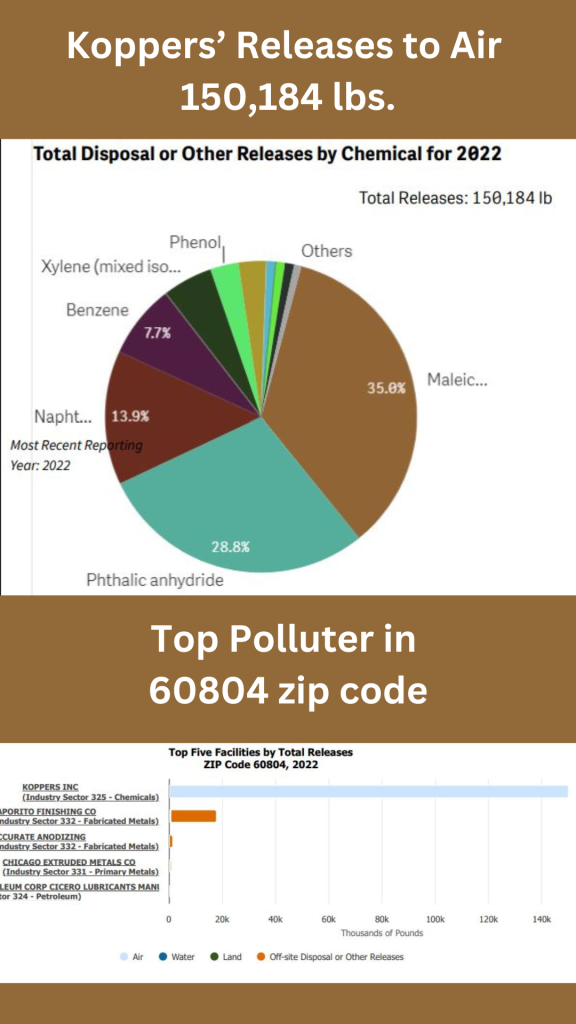
In the last year for which it reported emissions (2022), Koppers released into the Cicero and Stickney air nearly 21,000 pounds of naphthalene and 11,500 pounds of benzene. That’s 32,500 pounds of chemicals linked to cancer in a single year.
More than 16 tons.
Even worse, Koppers releases far more than just naphthalene and benzene. In 2022, Koppers also released other toxic chemicals as well, including chemicals known as xylene, maleic anhydride, and phthalic anhydride. When you add it all up, in that one year, Koppers released 150,184 pounds of these toxins.
That’s more than 75 tons.
Also, Koppers is by far the largest contributor to the air pollution in Cicero and Stickney. EPA has published information that allows us to see not only the quantity of toxic chemicals released by Koppers but also where Koppers ranks among other area polluters.
And when we look at the zip code (60804) that includes the Koppers plant, the EPA tells us that, among that area’s top 5 polluters, no other polluter makes any meaningful addition to the air pollution there.
The air pollution is caused essentially entirely by Koppers.
Koppers Is One of the Very Worst Air Polluters in the Entire United States
Koppers is not just the worst air polluter in the Cicero and Stickney area. It’s one of the worst in the entire country.
The federal government (EPA) has developed a scoring system to describe the hazard created by toxic chemical emissions from a polluter. It’s called the Risk Screening Environmental Indicators Hazard Score (RSEI Hazard Score). It’s a measure of the potential harm to human health based on (a) the toxicity of the chemicals a polluter is releasing, and (b) how many pounds of those chemicals it is releasing. When those two factors are considered, they form the polluters’ Hazard Score.

The EPA has also developed categories of RSEI Hazard Scores, so that polluters across the United States can be compared and ranked against one another, and we can know how big of a polluter a certain company is. There are 6 categories:
- A Hazard Score of 0, meaning no harm to human health.
- 0 to 100,000
- 100,001 to 10,000,000
- 10,000,001 to 100,000,000
- 100,000,001 to 1,000,000,000
- Over 1,000,000,000
Obviously, the biggest hazardous polluters are those in the final category, with RSEI Hazard Scores over 1,000,000,000.
For the year 2022, the EPA has calculated Koppers’ Hazard score to be 2,156,017,314. That’s more than 2 X the RSEI Hazard Score that it takes to get in the sixth category.
Bottom line: Koppers is one of the country’s most hazardous polluters.
The Air in the Community Surrounding the Koppers Plant is Some of the Most Contaminated Air in the Country
I’ve visited the neighborhoods surrounding the Koppers plant. Rows and rows of beautifully maintained homes. It’s immediately apparent that the residents of those communities are very proud of their homes and really care for them.
Sadly, however, hundreds of those homes are within one-half mile of the Koppers plant, and hundreds more are within one mile.
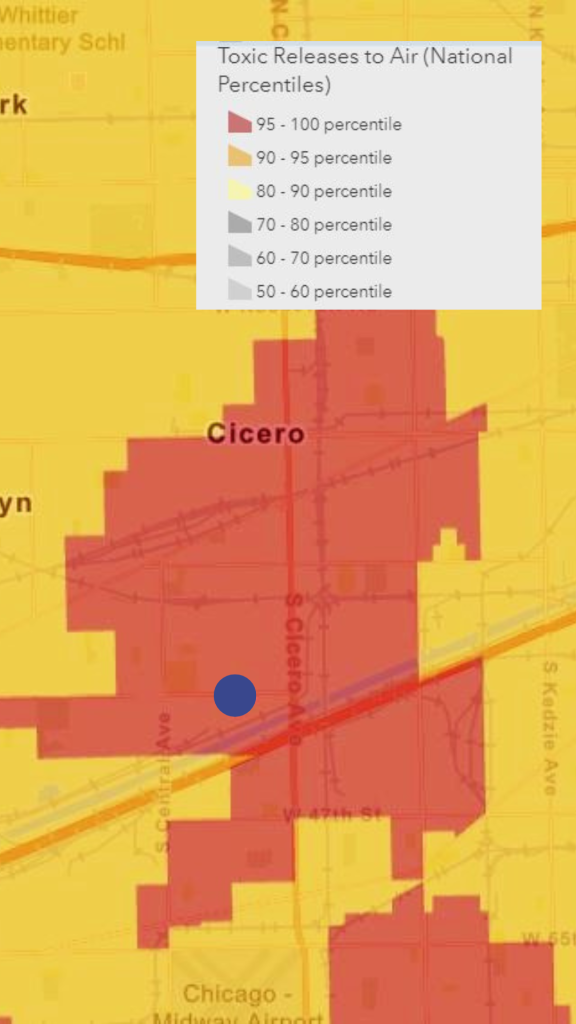
Well within reach of the many tons of toxic chemicals blowing out of the Koppers plant each year.
The EPA also shows us the impact of Koppers’ tons of emissions to the air in the community surrounding the plant. In other words, the air that the residents in those beautifully maintained homes actually breathe.
The EPA map color codes the area surrounding the Koppers’ plant according to how contaminated its air is. And you can see that the area immediately surrounding the plant—which includes many hundreds of homes filled with residents—is coded in a crimson color.
That crimson coding means, according to the EPA (see categories in the upper right on the graphic), that this area’s air ranks inthe top 5% of the most polluted air in the country. Thousands of residents live in homes in the crimson-coded area.
Clearly, these residents are breathing dangerous air.
Children are Most at Risk from Breathing Dangerous Chemicals.
The homes in these air-polluted, crimson-coded areas of Cicero and Stickney are filled with children, in the area’s homes, schools, daycare centers, and playgrounds. Public Health experts, and our common sense, tell us that breathing toxic chemicals is even more dangerous to children than to adults.

This is especially true of carcinogens. Cancer-causing chemicals can damage (or “mutate”) the cells in our body. The problem for children is that their cells are multiplying rapidly—that’s the growth process.
But if those cells rapidly multiplying inside a growing child’s body are damaged by contact with carcinogens, then damaged cells are rapidly multiplying, creating an environment where cancer (and other illnesses) can take hold and grow.
It is perhaps the most important point in all of this: children are especially at risk from breathing toxic chemicals, and profoundly so when they are breathing some of the most toxin-contaminated air in the country.
No One is Protecting the Residents of Stickney and Cicero

The best and most effective way to protect the children of Stickney and Cicero and their neighbors from the dangers of breathing Koppers’ toxic emissions is to not allow the emissions in the first place. But, as you can see from the information above, neither Koppers nor the EPA seems interested in doing that.
EPA’s apparent lack of interest is particularly concerning since EPA’s job is to protect public health, and in fact, the residents of Stickney and Cicero are paying taxes to fund the agencies (like the EPA) that are supposed to be protecting them.
When a community is as polluted as the area surrounding Koppers is, anyone determined to protect public health would start by testing the air that the residents are breathing, to find out just how dangerous it is. Testing in the places where the residents spend their lives—homes, yards, schools, parks, churches, etc.—to learn precisely what chemicals the residents are breathing, and in what concentrations.
And the testing should be frequent in each area, because measured concentrations of toxic chemicals can change rapidly over time, since the chemicals are being carried by air currents from Koppers, and perhaps other places, as well.
I’ve neither seen nor heard of this kind of testing being done in the neighborhoods—either by Koppers or the EPA. My experience has taught me that polluters, and sometimes even government, don’t want to do this kind of testing because they don’t want to have to deal with the consequences.
Imagine the outcry, and pressure to drastically limit Koppers’ massive chemical emissions, that would follow if test results were to reveal high concentrations of chemicals linked to cancer in area homes, or even worse, in a school or daycare center.
And yet it is that consequence which is the very reason why the testing must be done. Any serious effort to protect the children and their families requires it.
So does simple human decency.
Please watch ourvideo on Koppers.
The Collins Law Firm is one of the top environmental litigation firms in the country. We have represented thousands of victims of chemical contamination and have successfully fought to win clean air, clean water, and millions in compensation for them. If you live near the Koppers plant and believe your cancer may be caused by the toxic emissions from the plant, contact us at (630) 527-1595.
For more information, please read these news articles:
Para más información, por favor lea estos artículos de noticias:
The post THE DANGERS OF THE TOXIC CHEMICAL EMISSIONS FROM THE KOPPERS PLANT IN CICERO, IL appeared first on Collins Law Firm.
Toxic Chemical Chlormequat Found in Oat-Based Food and Humans, Threatens Reproductive Harm 20 Feb 2024, 6:24 am

For years, the big cereal companies have been telling us that a bowl of whole grain oat cereal for breakfast is a healthy way to start our day. Turns out maybe it isn’t.
A recent study by the Environmental Working Group (EWG) has uncovered a toxic chemical, chlormequat, in popular oat cereals like Cheerios and Quaker Oats.
Chlormequat should not be in our food supply. It is an agricultural chemical used to limit plant growth, making a plant sturdier and easier to harvest. In the U.S., the chemical is banned from being used on any food crops. However, the Environmental Protection Agency (EPA) inexplicably decided in 2018 to allow foods grown with chlormequat to be imported into the United States.
This makes absolutely no sense. If chlormequat is too dangerous to use on food grown here, why is it less dangerous on food grown elsewhere? Past studies have linked chlormequat to reproductive and developmental harm in animals. More specifically, the studies have linked the chemical to reduced fertility, altered fetal growth, and delayed puberty.
Unfortunately, the EPA’s misguided chlormequat policy has already had an effect on the American public. According to another EWG study, chlormequat has been detected in the majority of Americans tested, with detection rates rising steadily since 2018. In 2017, chlormequat was detected in only 69% of EWG’s study participants; by 2023 it was detected in 80% of participants. Considering how long the chemical stays in the body (24 hours), these findings suggest that Americans are being exposed to chlormequat on a regular basis.
One source of chlormequat exposure appears to be the food we are eating. EWG’s recent testing uncovered pervasive levels of chlormequat in oat-based foods, particularly in nonorganic products. Detectable levels of chlormequat were found in 13 out of 14 of the nonorganic oat-based cereals, oatmeal, granola, and granola bars tested, compared to only 1 out of 7 of the organic products tested. Even more concerning, eleven of the nonorganic products contained chlormequat at levels higher than the amount considered safe for children. This research raises concerns about the widespread presence of this potentially dangerous chemical in our food supply.
However, instead of showing concern about these findings and taking a step back to study the human health effects of chlormequat, the EPA is now proposing that we allow U.S. farmers to use chlormequat on oats and other grains grown here in the U.S.
Why?
Possibly because the agency has a history of caving in to pressure from the chemical industry. In 2017, Taminco, a major producer of chlormequat, petitioned the EPA to permit the chemical in oats imported into the U.S. In response, the EPA agreed to tolerate a certain amount of chlormequat in imported foods. After another petition from Taminco in 2020, the EPA increased that tolerance. Now, the company has submitted an application to the EPA to allow chlormequat to be used on oats and other grains grown in the U.S.
It seems that whatever Taminco wants, Taminco gets. No matter the consequences for the American people.
Agencies like the EPA are supposed to prioritize the protection of public health over the approval of potentially harmful chemicals. Safeguarding consumers from toxic substances like chlormequat is part of the mission of the EPA. Instead, they appear to be protecting the interests of industry.
We urge the EPA to change course and conduct a thorough investigation of the health effects of chlormequat before greenlighting the use of this potentially dangerous chemical in our food supply.
Until the US EPA decides to do its job, we recommend you choose organic oat products that are free from toxic chemicals like chlormequat.
The Collins Law Firm has been representing plaintiffs in toxic tort claims, class actions, and other environmental lawsuits against big polluters for over 20 years. If your health has been harmed by toxic chemical exposure, give our tough, experienced, environmental attorneys a call at (630) 527-1595.
The post Toxic Chemical Chlormequat Found in Oat-Based Food and Humans, Threatens Reproductive Harm appeared first on Collins Law Firm.
Collins Law Partner Shawn Collins Helps Negotiate $408 Million Settlement for Cancer Victims 13 Feb 2024, 6:30 am
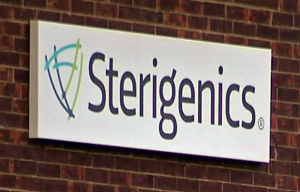
Attorney Shawn Collins, founder and partner of The Collins Law Firm in Naperville, Illinois, was instrumental in forging a $408 million settlement of the cancer claims of more than 800 plaintiffs in In re Willowbrook Ethylene Oxide Litigation, venued in Illinois State Court (Cook County). The claims arose after a federal government report announced in 2018 for the first time that a sterilization plant in Willowbrook, IL–operated by Sterigenics, LLC, and its predecessors–had been emitting a chemical known as ethylene oxide 24 hours a day into the residential community’s air for more than 30 years. Once it left the Sterigenics’ plant, the colorless, odorless ethylene oxide silently migrated a great distance, exposing people in homes, workplaces, and schools.
Ethylene oxide is widely used in the sterilization of medical devices and other items. It has been classified as a known human carcinogen by the International Agency for Research on Cancer (IARC) and the US Environmental Protection Agency (USEPA). It is especially dangerous to children.
Until the release of the government’s 2018 report, the residents of the Willowbrook area had never been told that such a dangerous chemical was infiltrating their community on a daily basis, or indeed at all. The more than 800 plaintiffs in the litigation were typically those who had been breathing the ethylene oxide—unknowingly—for years. After years of inhalation, most were then diagnosed with breast cancer, or lymphoma or leukemia—the cancers most strongly associated in medical studies with exposure to ethylene oxide.
The first trial in the Litigation was held in 2022. Shawn Collins was co-counsel on the trial. When the 6-week trial concluded, the jury returned a verdict for the plaintiff breast cancer survivor, Susan Kamuda, in the amount of $363 million. It was and remains the largest-ever single plaintiff verdict in Illinois, and that year was cited as one of the top 10 verdicts in the entire country.
$325 million of the jury’s award was for punitive damages, reflecting its resounding repudiation of the company’s recklessness in releasing such a dangerous chemical into the community, in such large quantities, so frequently, and without warning or protecting the residents against the chemical’s dangers.
In addition to serving as co-counsel in the Kamuda trial, Collins also was appointed by the Court to serve as one of three co-leads of the Litigation’s Plaintiffs’ Executive Committee (PEC), which was responsible for all aspects of the Litigation, advancing and protecting the rights of all plaintiffs in it.
Shortly after the Kamuda case verdict, and after months of negotiating–with co-PEC lead Collins taking a leadership role– the parties reached the $408 million global settlement of all plaintiffs’ claims against sterilization plant operator Sterigenics and its parent company.
“This agreement represents a remarkable achievement for the plaintiffs and the people affected by the ethylene oxide exposure,” stated Shawn Collins. “We are pleased to have reached a resolution that acknowledges the suffering endured by these individuals and their families.”
Case Information: In re: Willowbrook Ethylene Oxide Litigation, Circuit Court of Cook County, Illinois No. 2018L010475
Plaintiffs’ Executive Committee Co-leads: Shawn Collins of The Collins Law Firm, Patrick Salvi of Salvi Schostok & Pritchard, and Antonio Romanucci of Romanucci and Blandin. The court-appointed Plaintiffs’ Executive Committee included attorneys from The Collins Law Firm P.C.; Romanucci & Blandin, LLC; Smith LaCien LLP; Salvi Schostok & Pritchard, P.C.; Hart McLaughlin & Eldridge, LLC; Tomasik Kotin & Kasserman, LLC; Miner Barnhill & Galland, P.C.: and Clifford Law Offices.
If you have developed Non-Hodgkin’s lymphoma or breast cancer after years of exposure to ethylene oxide, we can help you determine if you have a legal claim against the company responsible for the contamination. Our environmental attorneys have years of experience represents plaintiffs suing corporations for polluting the groundwater or air in their neighborhoods. Please call us at (630) 527-1595 to talk to an experienced ethylene oxide contamination attorney for FREE.
The post Collins Law Partner Shawn Collins Helps Negotiate $408 Million Settlement for Cancer Victims appeared first on Collins Law Firm.
Top Verdict in Illinois in 2022 13 Feb 2024, 6:24 am
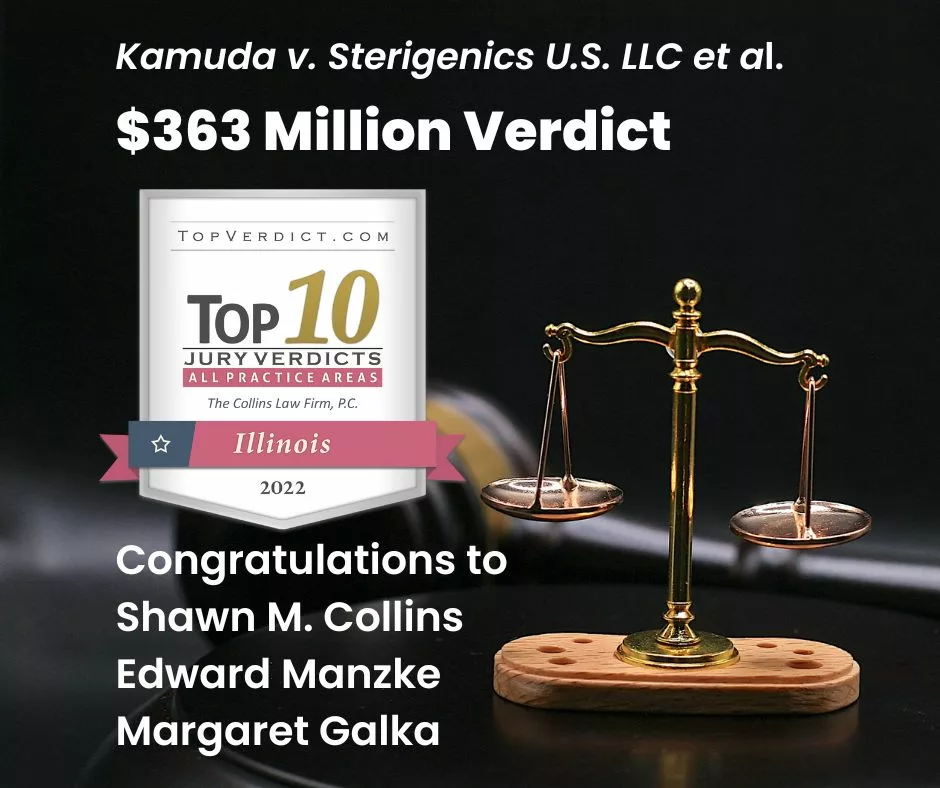
We are proud to announce that our $363 million verdict in Kamuda v. Sterigenics U.S. LLC, et al., was named the number one jury verdict in Illinois in ALL practice areas in 2022 by Top Verdict. In addition, this verdict was the second highest personal injury verdict in the entire United States and the number 10 verdict in ALL practice areas in the U.S. in 2022, according to Top Verdict. Congratulations to Collins Law partners Shawn Collins and Edward Manzke and associate Margaret Galka for their work on the trial team that secured justice in this important environmental toxic tort case.
Amount of Verdict: $363,000,000, including $325 million in punitive damages and $38 million in compensatory damages.
Attorneys: Patrick A. Salvi II, Lance D. Northcutt, Jennifer M. Cascio of Salvi Schostok & Pritchard PC; Shawn M. Collins, Margaret Galka of The Collins Law Firm, PC; Scott A. Entin, Roisin Duffy‐Gideon, Deanna N. Pihos of Miner Barnhill & Galland PC
Case: Kamuda v. Sterigenics U.S. LLC, et al.
Type: Personal Injury, Toxic Exposure, Negligent Tort, Public Nuisance, Bodily Injury
For a complete listing of the top verdicts in Illinois, see here.
To contact one of our experienced environmental attorneys or personal injury lawyers, call (630) 527-1595 for a FREE consultation.
The post Top Verdict in Illinois in 2022 appeared first on Collins Law Firm.
The Collins Law Firm Preparing to File a Case Against CTA for Train Crash Victim 23 Nov 2023, 6:24 am
The personal injury attorneys at The Collins Law Firm are representing a passenger injured in the recent CTA train crash in Chicago and preparing to file a case against the Chicago Transit Authority.

CTA Train Crash Sends 23 Passengers to the Hospital
The CTA train crash—which occurred when a Yellow Line train struck a CTA snow plow train doing scheduled training in the Howard rail yard– injured 38 people and was the largest train crash in decades. This tragic and unexpected crash sent 23 people to the hospital, including three in serious condition. Commuter train crashes like this are relatively rare, but when they do happen, they can injure or kill dozens of passengers. After a crash like the one in Chicago, the injured victims will need an experienced train accident attorney to safeguard their legal rights.
CTA, Metra, and Amtrak are the most well-known trains in the Chicago area. However, Illinois’ train system is much larger than that. Illinois has 41 railroads currently operating, with about 9,982 miles of railroad tracks. When you compare those numbers with the fact that, on average, a train accident occurs every 3 hours in the United States, you may feel a little uneasy. Most of those accidents, however, involve freight trains moving at low speeds and do not result in serious injuries. By contrast, passenger trains travel much faster and do not require any special protection–such as seatbelts– for passengers. So, when a passenger or commuter train is involved in a crash, it can result in severe, life-threatening or catastrophic injuries. Having an experienced train accident attorney from the Collins Law Firm will help to ensure that you get the compensation you deserve if you are injured in a train accident.
What Causes a Train Accident?
There are many factors that can cause a train accident. Lack of maintenance, driver error, track issues, signal error, pedestrian crossings, cars stopped on tracks, speeding, and train derailment are the most common causes. In many of these cases, the train company is at fault. By law, it’s their responsibility to keep passengers safe. So, when they fail to do so, they can be held liable. At The Collins Law Firm, we will take all the steps necessary to determine who was responsible for your train accident and to build the strongest case for you.
Common Injuries After a Train Accident
Serious train accidents, whether caused by a derailment, collisions with vehicles or other trains, or pedestrian incidents, can result in severe injuries to passengers. Some of the common injuries observed in train accidents are:
- Traumatic brain injuries, from mild concussions to more severe injuries causing permanent impairments requiring lifelong care.
- Spinal cord injuries, including nerve damage and paralysis. Spinal injuries often necessitate multiple surgeries and extensive rehabilitation.
- Broken bones
- Significant lacerations or abrasions
- Severe burns, scarring, or disfigurement
- Internal injuries
- Amputations
How Do Common Carrier Laws Affect Liability in a Train Accident?
Common Carrier Laws apply to any company that transports goods or people for a fee, including trains, buses, and planes. These laws require railroad companies to provide the highest degree of care and vigilance to prevent any harm coming to their passengers. Properly hiring and training employees and regular train inspections and repairs are just a few examples of what is expected of railroad companies. If a railroad is negligent and fails to prioritize the safety of the people they are transporting–as required by Common Carrier Laws–it can be held responsible for any losses or injuries that result. When that happens, the Collins Law Firm is prepared to step in and handle the process of building your case and getting you the compensation you deserve, while you focus on recovering from your injuries.
Why You Should Choose the Collins Law Firm for Your Train Accident Claim
At The Collins Law Firm, we have been representing injured plaintiffs just like you for nearly 30 years. Our accident attorneys are experienced with handling train accident cases and committed to fighting for you. You can trust that we will vigorously advocate for you, protecting your legal rights and ensuring that you receive full compensation from those responsible for your injuries. From investigating the factors leading to the train accident to compiling evidence and seeking assistance from reputable experts, we will be actively involved in every step of the process to safeguard your interests. Most importantly, we will not rest until you get the justice you deserve. Fill out our contact form or call us at (630) 527-1595 for a free consultation to discuss your train accident claim today.
The post The Collins Law Firm Preparing to File a Case Against CTA for Train Crash Victim appeared first on Collins Law Firm.
Shawn Collins’ Feature Interview in Lawyer Monthly Magazine 4 Sep 2023, 6:24 am
Partner Shawn Collins is featured in an interview in Lawyer Monthly magazine this month. Below is an excerpt from the article.
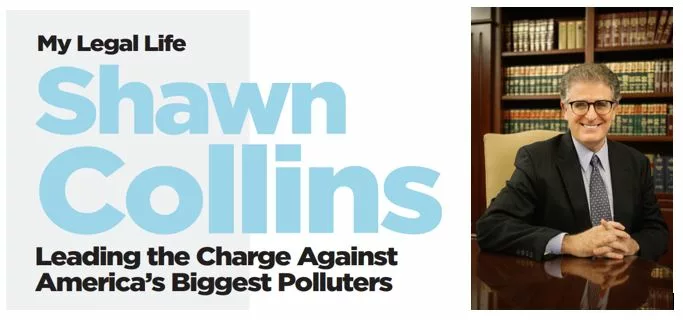
Leading the Charge Against America’s Biggest Polluters
Instances of harmful pollution and ecological disasters have grown unsettlingly commonplace in the US – despite environmental regulations that appear strict on paper. Why is this, and how can polluting corporations be held responsible for the damages they cause? Enter Shawn Collins, the ‘environmental lawyer for the people’. In this exclusive interview, Shawn shares a look at the work he does and the clients who come to him, as well as a glimpse into the ongoing battle to hold polluters accountable in the US.
My Work and My Clients
I have fought polluters for more than 23 years. My clients are individuals, families, and communities whose air and water have been contaminated by the reckless discharge of dangerous chemicals – usually carcinogens – from factories, industrial parks, and landfills.
In my cases, chemicals with names like TCE, PCE, DCE, vinyl chloride, ethylene oxide, arsenic, toluene, and glyphosate were poured, spilled, dumped or spewed into the air – often for years – by companies who did not care to spend the money to dispose of the chemicals responsibly or protect those they knew would be exposed. Left to migrate throughout the environment and find their way into homes, schools, churches, and parks, these toxins were then inhaled and consumed by residents who had no idea the chemicals were even there, let alone how badly their health was being threatened. No one bothered to tell them. Not the polluter. Not even their government.
To continue reading the full article, click here: https://www.lawyer-monthly.com/2023/08/leading-the-charge-against-americas-biggest-polluters/
The post Shawn Collins’ Feature Interview in Lawyer Monthly Magazine appeared first on Collins Law Firm.
Toxic PCBs in Schools: Why Aren’t States Protecting Children? 8 Aug 2023, 4:36 am

PCBs – the common term for polychlorinated biphenyls – are toxic manufacturing compounds that do not occur in nature and have been linked to various health problems with the liver, thyroid, skin, and eyes. Moreover, they have been classified as probable human carcinogens by the EPA and the International Agency for Research on Cancer (IARC), based on animals studies that provided conclusive evidence that PCBs cause cancer. And they are commonly found in light ballasts and building materials in schools.
PCBs were manufactured by Monsanto for use in a multitude of products, from floor finishers and oil paints, to caulk, carbonless copy paper, and the ballast contained in fluorescent lights. They are nonflammable, chemically stable, and excellent electrical insulators, making them convenient and versatile in the manufacturing process. However, the price for these manufacturing conveniences – the disastrous consequences they can have on health – is far too steep to pay, and in 1979, they were effectively banned by the U.S. government. But this should have been only the first step – and the next steps have been slow in coming.
The health threats posed by products containing PCBs didn’t disappear with the manufacturing ban. PCBs have very slow decomposition rates and retain their toxicity even in very low concentrations. Animals that ingest them can then pass them up the food chain and contaminate an entire ecosystem. And this isn’t even touching on schools – where testing consistently turns up high concentrations of PCBs.
However, there is no consistent testing. No federal regulations require cleanups, or even reports, of PCBs. A similarly hazardous material, asbestos, led to the Asbestos Hazard Emergency Response Act (AHERA) implemented by the Environmental Protection Agency (EPA). This law requires all public schools–as well as private charter and religious schools––to be inspected and to implement a rigorous remediation plan if asbestos is found.
By stark contrast, PCB testing and remediation in schools are not required but rather are left to a state’s discretion. And most states do not have comprehensive plans in place to clean up or even identify contaminated schools.

Illinois has laws that protect aquifers and other sources of potable water from PCB contamination, but none that protect schools. Any schools built or remodeled during the era of PCB manufacturing, over the course of 50 years from 1929 until the late 1970s, would be at serious risk of PCB contamination, most commonly from caulk and the ballast leaking from broken fluorescent lighting fixtures. A 2016 study from the Harvard School of Public Health estimated that this impacts anywhere between 13,000 and 26,000 schools, and up to 14 million students in the United States. Some of the most vulnerable children are being put into toxic environments for years at a time, and there are very few controls in place to safeguard them.
Which is why a new lawsuit filed by the state of Vermont and its Attorney General Charity Clark against Monsanto for the PCBs in Vermont schools is such a big deal. The lawsuit alleges that for decades, Monsanto knowingly produced products with dangerous PCBs and was aware of these many dangers long before the federal ban in 1979.
The lawsuit against Monsanto seeks to recover the funds necessary to test, clean, and refurbish schools until they are safe from the threat posed by Monsanto’s PCBs. The lawsuit alleges that Monsanto not only knew about the threat to health caused by PCBs but also knew that its products would contaminate indoor and outdoor environments – and continued producing them anyway.
Monsanto is the logical defendant in the Vermont lawsuit. Monsanto’s PCBs caused the need for testing and cleanup in the state’s schools. It is common sense that Monsanto should be held accountable for its reckless disregard for human safety as it aggressively pursued profit. Monsanto should foot the bill to repair the damage still being wrought by their actions decades ago.
Vermont is the first state to bring a lawsuit over the contamination of schools by PCBs and one of the first to have a law requiring schools built or renovated before 1980 to test their PCB levels. But Vermont should not be the last. PCBs are a biohazard that widely impact tens of thousands of schools and millions of children across the United States.
They are finally beginning to be recognized and treated as the danger that they are.
The post Toxic PCBs in Schools: Why Aren’t States Protecting Children? appeared first on Collins Law Firm.